Sofya Olzeeva, Traditional Dwelling
Duration: 6 mins 1 sec
Share this media item:
Embed this media item:
Embed this media item:
About this item

| Description: | Sofya says that in the past the Kalmyks, including her parents and grandparents, lived in yurts. |
|---|
| Created: | 2015-09-27 12:01 |
|---|---|
| Collection: | Kalmyk Cultural Heritage Project (ARCHITECTURE) |
| Publisher: | University of Cambridge |
| Copyright: | University of Cambridge |
| Language: | xal (Kalmyk; Oirat) |
| Abstract: | Sofya says that in the past the Kalmyks, including her parents and grandparents, lived in yurts. Although she herself did not grow up in a yurt, Sofya saw this nomadic dwelling when she was a child. Sofya says that the Kalmyk yurt consists of the wooden wall (term) arranged in a circle. The roof poles (unin) support the roof ring. In the past, the poor who could not afford a yurt lived in constructions called zholm, a tent-like construction made from roof poles but without walls. In Sofya’s childhood Kalmyks also lived in mud houses made from wild cane. Women’s life was hard: it was their duty to smear their houses with mud, bring water, to do the washing, cooking, and other household chores. In the past, the wealthy covered their yurts with white felt, whereas the less well-off had to contend with brown felt. At night, the roof ring was covered with a felt cover, and in the morning the cover was pulled down to let light into the yurt. The centre of the yurt had a tripod (tulg) on which people cooked their meal. Dung was used for fuel. The door was made from wood. Those who could not afford a wooden door covered their door with felt. During the day, the felt-cover was rolled up, and at night rolled down.
|
|---|---|
Available Formats
| Format | Quality | Bitrate | Size | |||
|---|---|---|---|---|---|---|
| MPEG-4 Video | 640x360 | 1.9 Mbits/sec | 86.04 MB | View | Download | |
| WebM | 640x360 | 2.02 Mbits/sec | 91.63 MB | View | Download | |
| iPod Video | 160x120 | 288.39 kbits/sec | 12.71 MB | View | Download | |
| MP3 | 44100 Hz | 249.97 kbits/sec | 11.05 MB | Listen | Download | |
| Auto * | (Allows browser to choose a format it supports) | |||||

